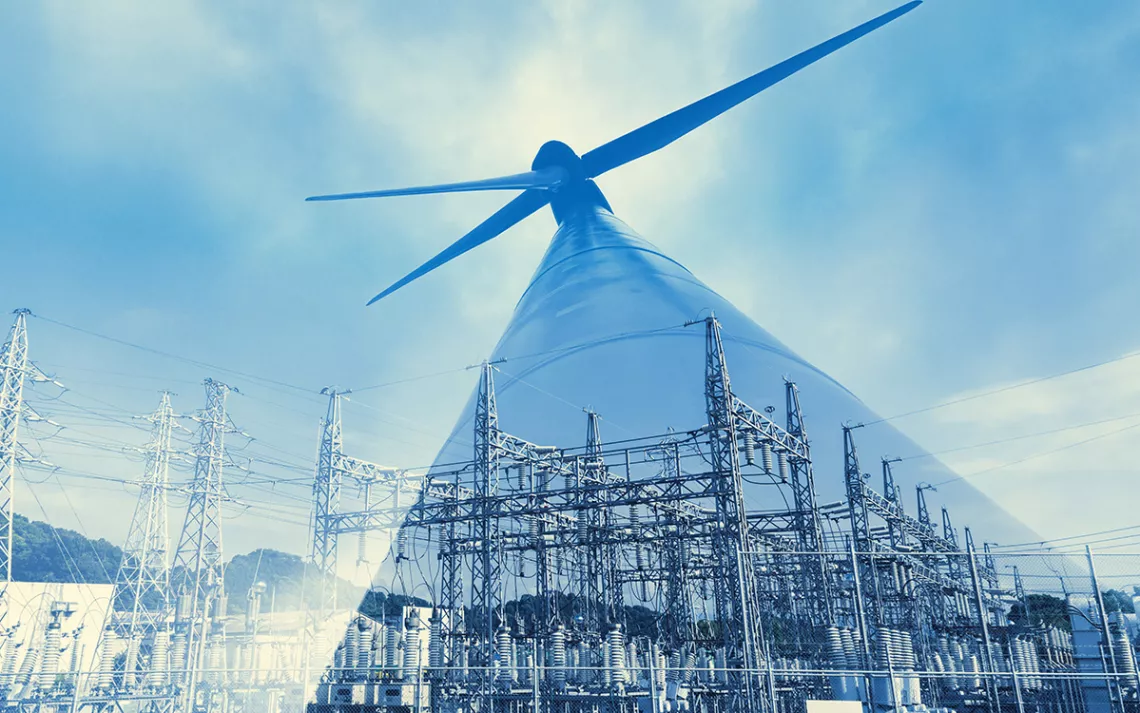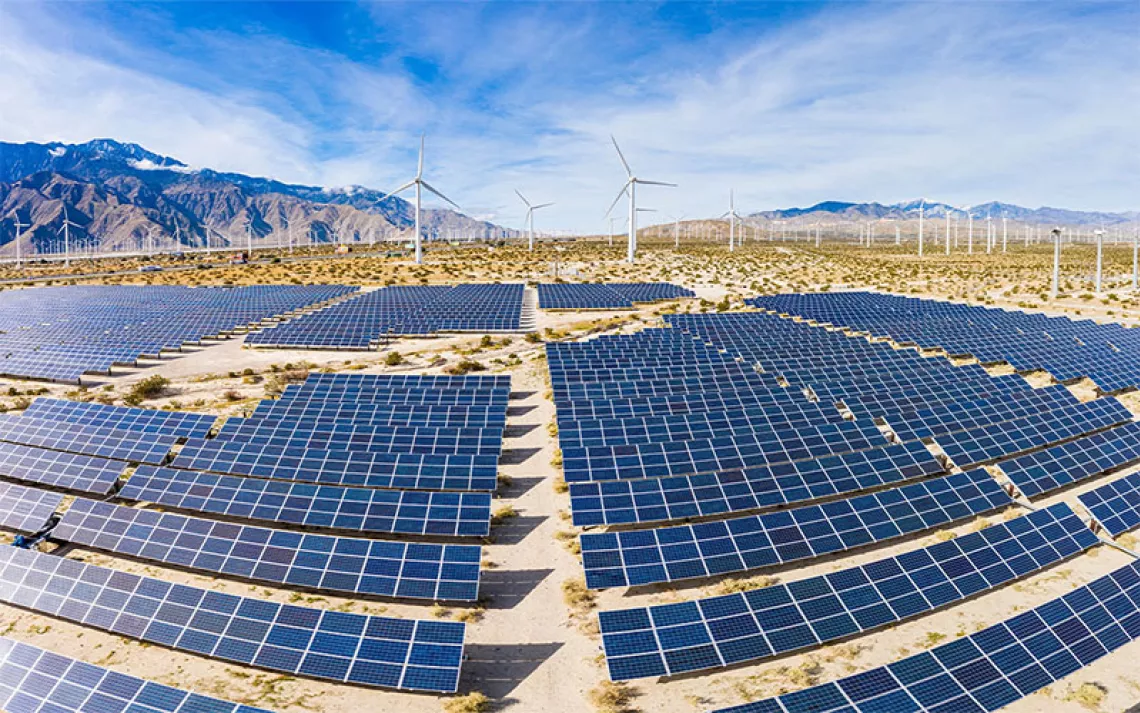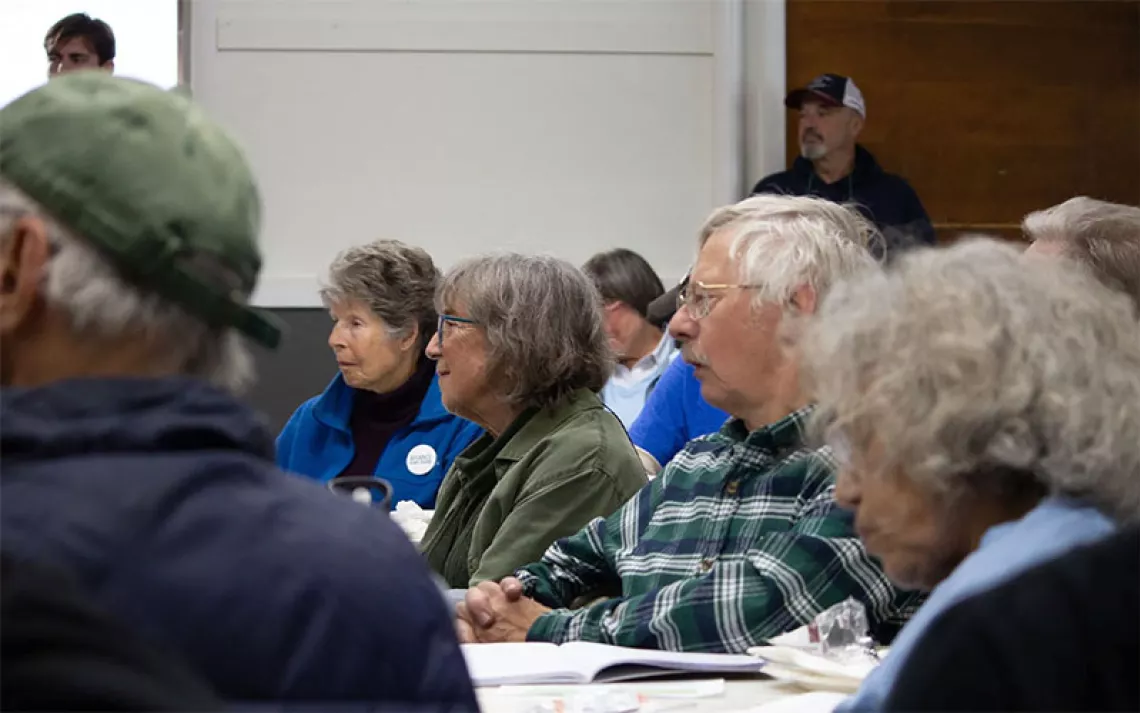Yes, We Need to Build a Lot More Renewable Energy a Lot Faster. But Scrapping Environmental Laws Isn’t the Way to Do That.
Do we really need “permitting reform”?

Photo by iStock/metamorworks
Will we have to sacrifice some local ecosystems and bedrock US environmental laws in order to preserve the global climate? That question, in some form or another, dominated environmental debates earlier this fall as Congress considered a proposal from Senator Joe Manchin, the West Virginia Democrat, to water down some US laws and regulations in the name of speeding up energy development across the country.
Manchin’s ill-fated bill was premised on his assumption that a legislative overhaul is needed to cut the red tape that results in chronic delays of building new energy projects. National environmental organizations like Earthjustice and the Sierra Club—along with local environmental justice groups—disagreed. And they fought hard to block what they saw as a cynical attempt by a senator who has accepted enormous sums of money from the fossil fuel industry to water down environmental laws and clear the path for more dirty infrastructure such as the fracked gas Mountain Valley Pipeline. In late September, Senator Manchin pulled the plug on his “permitting reform” legislation after it became clear he didn’t have the votes.
The legislative fight sparked real debate and divisions within the climate-action community, much of it in good faith. Manchin’s bill included some reforms that would potentially speed up clean energy deployment, such as enhanced federal authority to site new transmission lines. Many Democrats and clean energy advocates viewed those changes as critical enough to support the permitting reform bill that was on offer.
“The environmental movement that I grew up in was organized around stopping inappropriate projects, and I think that remains an essential aspect of the environmental movement and always will be,” Democratic senator Brian Schatz, a stalwart environmental champion, told Honolulu Civil Beat in September, explaining his support for Manchin’s bill. “But the environmental movement that addresses climate also has to be about building things, and so we need to make it easier to build these big planet-saving projects or we’re going to never meet the moment.”
Essentially, the question was whether climate advocates inside and outside of Congress should accept the “bad” in order to get the “good.” Although the bill has been shelved for now, Senator Manchin is eyeing another chance at forcing through his version of reform before the end of the year by attaching it to must-pass legislation, such as a bill to fund the Pentagon. In the days after the midterm elections, the White House signaled support for such an effort.
The debate over what needs to be done in order to accelerate the energy transition remains. The landmark Inflation Reduction Act, signed into law in August, promises to cut greenhouse gas emissions by an estimated 42 percent by 2030. With massive clean energy subsidies in hand, the economic logic of renewable energy is now impossible to ignore.
The emissions reductions, however, are not guaranteed. The United States, as a whole, is still not building and installing solar panels, wind turbines, and power lines fast enough to slash carbon pollution. Everyone agrees we need to be moving quicker. But many environmental policy experts are frustrated that the push for “permitting reform” has largely been aimed at weakening environmental laws, and they maintain that Manchin’s vision is not the way to go.
So: What would “good” permitting reform look like? How can we accelerate the construction of new transmission lines that would then unlock a tidal wave of new wind, solar, and energy storage? How can we integrate regions so that sunny and windy locales can supply power-hungry cities at great distances from one another? How can we do all of this much faster so that we can shut down carbon-spewing coal- and gas-fired power plants as quickly as possible? And how can this be done in such a way so that the clean energy transition is transparent and responsive to public input?
Much of the conversation inevitably comes back to the need to build new transmission lines capable of handling a new clean energy electricity system.
“I do think that transmission is the fulcrum of the clean energy transition. Unfortunately, it does put a lot of people to sleep once you start talking about,” Emily Moore, a senior researcher at the Seattle-based Sightline Institute, told Sierra. “The truth is we're not going to meet our climate goals if we don’t have more transmission.”
While the Inflation Reduction Act is designed to supercharge the construction of renewable energy, the bulk of the emissions reductions would not occur unless the rate of construction of new high-voltage long-distance transmission lines is doubled compared to recent historical trends, according to an analysis from Princeton University’s REPEAT Project. Another study found that a staggering 930 gigawatts of zero-carbon electricity projects were sitting in a queue at the end of 2021 waiting for transmission access. Not all of those projects are economically viable, but needless to say the backlog is immense.
There are a couple of ideas on the drawing board to push things along. One is to give the Federal Energy Regulatory Commission (FERC) the ability to site new transmission lines across the country. As it stands, FERC—a powerful agency largely unknown to the general public—has the ability to approve new fracked gas pipelines but not transmission lines. That makes it easier to build a methane-spewing gas pipeline than it does to build a power line that moves clean solar-generated energy.
In addition, when projects undergo federal permitting, that triggers separate state-permitting processes in many states, which can result in additional delays. But if expanded FERC authority is on the table, said Greg Wannier, a staff attorney with the Sierra Club’s Environmental Law Program, the process should also be friendlier to input from local communities. Granting more power to FERC would be a “win-win,” he said. “We can get transmission lines into this more expedited process that gas pipelines have but also make that process much more protective of the local communities that are impacted.”
But if expanded FERC authority is on the table, advocates say, the process should also be friendlier to input from local communities. “We're exploring a win-win where we can get transmission lines into this more expedited process that gas pipelines have, but also make that process much more protective of the local communities that are impacted,” Wannier said.
Another idea would be to require regional grid operators to have stronger connections with one another, which would smooth the transfer of electricity across long distances. Currently, the United States is carved up into separate regional grids. There are grid operators for the mid-Atlantic, New England, the Midwest, the Southwest, and California. Uniquely, Texas has its own grid that is almost entirely disconnected from the rest of the country. While many of the regional grid operators have connections with one another, only small amounts of power are shared among them.
FERC is in the process of finalizing new rules that could address a lot of bottlenecks. The FERC reforms would overhaul how regional transmission projects are planned, and crucially, who pays for them and how the costs are divvied up. The FERC rule proposes requiring utilities and grid operators to plan for 20 years, to consider broad benefits of new transmission, and to incorporate state climate policies into their plans.
The rulemaking, arcane as it is, could be a big deal. There is a misconception that “permitting” new transmission projects is the core of the problem, when in reality, planning new projects and funding them are bigger problems, Wannier said. It’s these other two issues that the new FERC rules could help address. “We're hopeful these reforms are going to substantially improve the planning and funding parts of transmission build-out,” he said.
He likened the clean energy bottleneck to a person sitting in their car at a red light, waiting to move. But the car is broken and is also out of gas. “Once you fix the car and put gas in the tank—then that red light is a problem if it stays red,” Wannier said. “We are working on the bigger problems and we hope they'll be fixed. But once they're fixed, we should also fix that red light.” He said the new FERC rules, if done right, could fix the car and put gas in the tank. The remaining issue of “permitting reform” then becomes the next problem to tackle.
Moore of the Sightline Institute agreed. “I do think a lot is getting lumped into the ‘permitting’ bucket. There’s a big bottleneck that's not about permitting,” she said.
In an analysis that looked at the transmission problems in the Pacific Northwest, Moore found that no entity is really planning long-distance transmission lines and there’s the same problem of how to pay for them. “I feel like we have some first-order problems, in this region at least, where we don't even know what the plan is and nobody is even really trying to build things,” Moore said. “So, it's not like there's projects that are sitting waiting to be permitted. We don't even really have a plan, or projects.”
Both Oregon and Washington aim to fully decarbonize their grids over the next two decades or so, but Moore’s analysis found that the region may fall short without new power lines that can carry wind and solar from Montana and Idaho to major population centers on the coastal side of the Cascade Range.
Moore said the state governments should consider looking at financing and building new transmission on their own. She pointed to Texas, a state that funded $7 billion for transmission lines more than a decade ago to ferry wind power from the gusty panhandle across much of the state. Texas now ranks number one in wind power generation.
A recent report from the Nature Conservancy found that the American West has 20 times the available land needed to build enough solar and three times the suitable land needed to build wind, in order to reach net-zero emissions by mid-century while avoiding sensitive habitats. In other words: A full transformation of the energy system is possible, but a better planning process is a prerequisite.
Even as Congress looks at legislative reforms, there is an enormous opportunity to use existing federal authorities to accelerate clean energy deployment, said Erik Schlenker-Goodrich, executive director of the Western Environmental Law Center.
The Manchin bill imposed time limits on environmental reviews under the National Environmental Policy Act (NEPA), a bedrock environmental law. Schlenker-Goodrich said that instead of going that route—which would weaken protections—the NEPA process could instead have guardrails that both protect local communities while also providing “predictability” to project developers.
What would those guardrails look like? He said environmental reviews should undergo a required sequencing. New projects should avoid ecosystem and community impacts. If they can’t avoid impacts, then impacts should be mitigated. If mitigation isn’t sufficient, communities should be adequately compensated. Some of this exists in the current process, but instead of actual public participation, agencies are “stuck in a check-the-box world.”
“People want to be heard. That doesn't necessarily mean more process. That means more effective process,” he said. The public should be involved at the front end before a project feels like a “done deal,” he said.
A June study from MIT looked at 53 utility-scale renewable energy projects and the causes for delay. There was a long list of reasons for why affected communities objected, but the ultimate conclusion from the study was that engagement with all stakeholders early on would “save time and money.”
“If it feels like some developers coming to town and the agencies are just checking the box on a NEPA process, and they're going to blaze a transmission line right through homes and your backyard, you might be pissed,” Schlenker-Goodrich said. “And then you're going to be pissed at the agencies, and you're going to be pissed at the developer. And you're not going to be inclined to come to the table. You're going to be inclined to fight.”
Rather than watering down environmental laws, reinforcing them might actually speed projects along if they incorporate, assess, and respond to local grievances up front. “To avoid delays, de-risk projects, and protect communities, we need to strengthen, not gut, the bedrock environmental protections of NEPA,” Jill Tauber, vice president of litigation, climate, and energy at Earthjustice, told Sierra.
She said Congress should pass the Environmental Justice for All Act, a bill that would require federal agencies to engage with fenceline communities on projects at the outset. The agencies would also need to take into account cumulative and historical impacts in the community when assessing whether the project in question will make things worse.
Schlenker-Goodrich said another idea would be to use NEPA as a clearinghouse for the rest of the federal permitting process. Currently, a transmission line may need to get a Clean Water Act permit from the EPA and an Endangered Species Act “incidental take” permit from the Fish and Wildlife Service, for example. One agency tends to wait to do its work while another permit is outstanding. It’s all very siloed.
Instead, Schlenker-Goodrich said, NEPA could be a “one-stop shop for planning, environmental review, and permitting,” speeding up the review and cutting down on the time it takes to get a project off the ground.
Ultimately, the status quo is not working, and the US is in danger of falling short of its climate goals because we aren’t building clean energy fast enough. Some sort of reform is needed. But the way to get there is not to remove protections for local communities and give a green light to new fracked gas pipelines.
“We support the clean energy build out. The best way to do that is to bring people along for the ride in a way where they are benefiting,” Schlenker-Goodrich said. “So, you are creating a social economy positive feedback loop where people see good decisions that lead to good results. Greenhouse gas emissions are reduced, people and communities are respected, and ecological values are not trampled on,” he said. “And then people are like, ‘Let's do more.’”
 The Magazine of The Sierra Club
The Magazine of The Sierra Club



